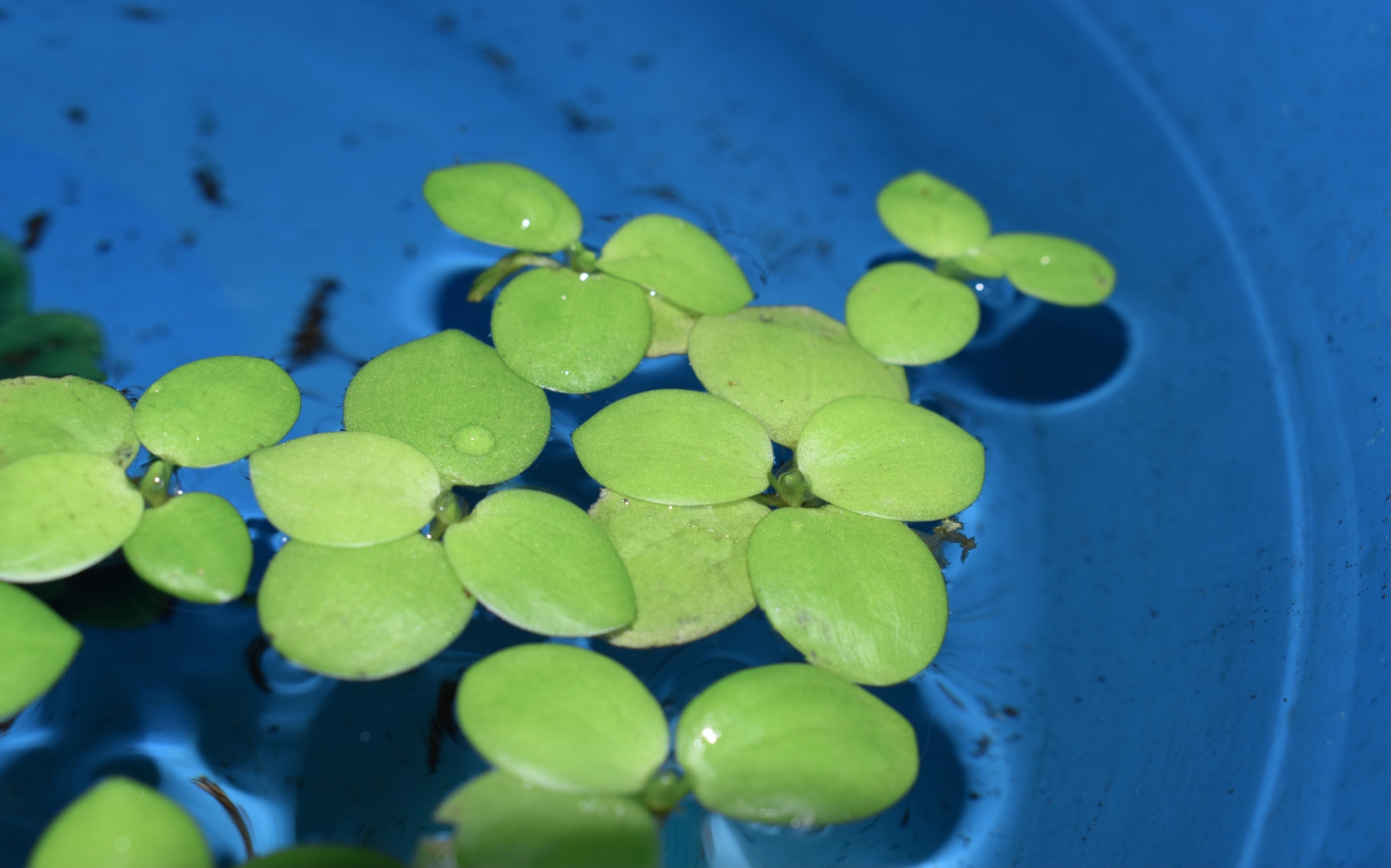
Floating aquarium plants can introduce a unique aspect to your tank, transforming its look and feel. With their roots hanging freely in the water, they evoke a sense of weightlessness, adding an ethereal quality that captivates both seasoned aquarists and newcomers alike.
Whether you’re looking to enhance the aesthetic appeal of your tank or address specific aquatic challenges, understanding the suitability of different floating plants is key.
In this article, I will take you through a diverse array of floating plants, providing an overview of options you may want to consider adding to your tank.
Key Takeaways
- Floating aquarium plants provide shade and cover for fish, creating a natural habitat where they can hide and feel secure.
- These plants serve as a dietary supplement, offering essential vitamins, minerals, and fiber that may be lacking in commercial fish feed.
- Floating aquarium plants promote aeration and oxygenation by releasing oxygen through photosynthesis, creating a healthier environment for fish to thrive.
- They also act as natural filters by absorbing excess nutrients from the water, helping to maintain water quality and prevent unwanted algae growth.
- The great thing about floating plants is they don’t need CO2, they get it from the atmosphere.
Popular Types of Floating Aquarium Plants
Let’s explore some of the most sought-after species that can enhance your tank’s aesthetics and contribute to a healthier aquatic environment.
1. Red Root Floater ‘Phyllanthus fluitans’ add to the paragraphs
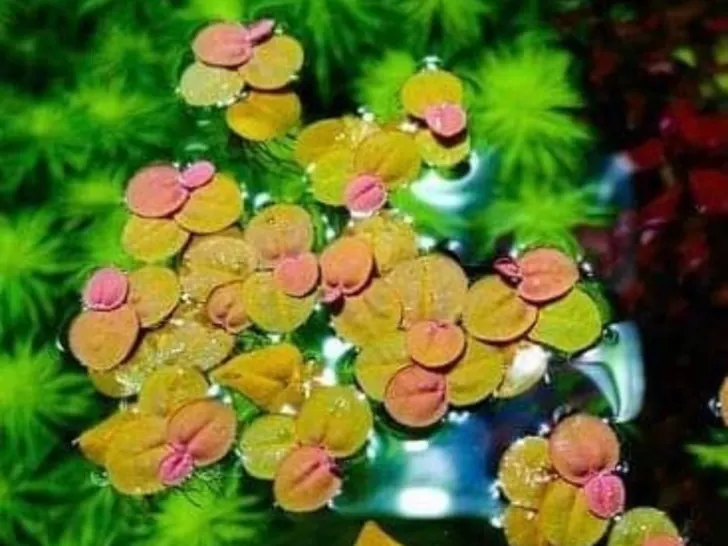
- Family: Phyllanthaceae
- Tank placement: Floating
- Care level: Easy
- Growth rate: Moderate – High
- Water temperature: Between 70°F to 82°F (21°C to 27°C)
- Water pH: Between 6.5 – 7.5
- Water hardness: 10 – 12 dGH
- Water current: Gentle water flow
Red Root Floater is a popular floating plant, especially for beginners. This captivating plant has petite, heart-shaped leaves that beautifully transition from light green or yellow to a deep vibrant red under high lighting conditions.
Its thin roots clump together beneath the water surface, creating an enchanting underwater forest for fish and other aquatic tank mates. It is well-regarded for its ability to oxygenate water and provide shade, creating a healthier and more visually appealing aquarium.
In its native habitat, Red Root Floater forms dense mats on the water’s surface, providing refuge for aquatic creatures and helping maintain water quality. Due to its striking appearance and beneficial properties, it has become a popular choice for aquariums worldwide.
2. Duckweed ‘Lemna minor’
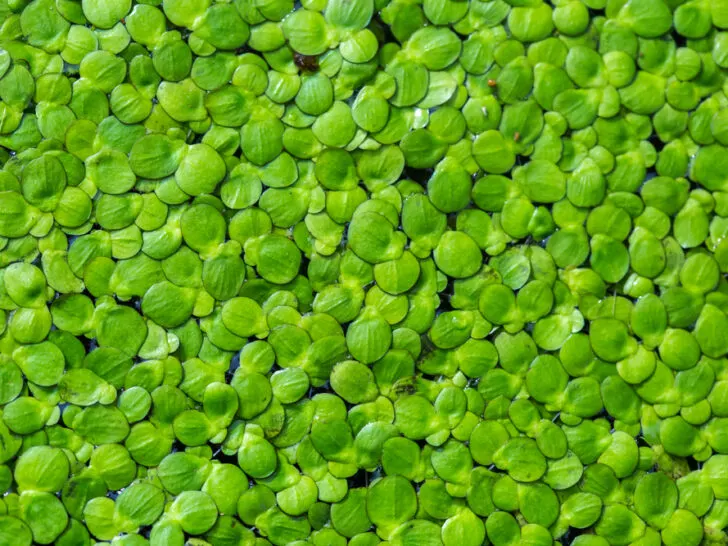
- Family: Araceae
- Tank placement: Floating
- Care level: Easy
- Growth rate: Very fast
- Water temperature: Between 60 – 90°F (15 – 32°C)
- Water pH: Between 6.5 – 7.5
- Water hardness: Between 1 – 12 dKH
- Water current: Gentle water flow
Duckweed, scientifically known as Lemna minor, brings a unique touch with its dainty, oval-shaped leaves that float freely on the water’s surface. Its leaves typically form a dense, interconnected mat that covers the water’s surface.
Its rapid growth is a significant advantage, as it efficiently absorbs excess nutrients in the water, contributing to the prevention of algae growth. Additionally, it forms an excellent habitat for your fish, particularly fry seeking shelter beneath its petite floating leaves. Furthermore, Duckweed serves as a nutritious food source for your fish; you can easily scoop it out of your tank, blend it, and then use it as fish food.
One drawback of this plant is its rapid growth rate. If you inadvertently transfer even a small amount of duckweed from one tank to another, perhaps on your finger or a net, it can proliferate quickly, spreading like wildfire in the new environment.
3. Amazon Frogbit ‘Limnobium laevigatum’
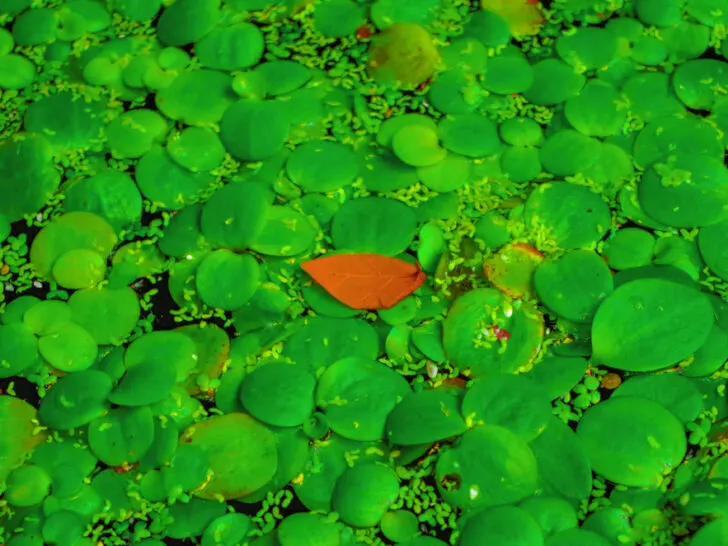
- Family: Hydrocharitaceae
- Tank placement: Floating
- Care level: Easy
- Growth rate: Moderate to fast
- Water temperature: Between 64 – 86°F (17 – 30°C)
- Water pH: 6.0 – 7.5
- Water hardness: Between 4 – 20 dKH
- Water current: Gentle water flow
Amazon Frogbit, scientifically known as Limnobium laevigatum can add beauty and natural charm to your tank. With its vibrant green leaves and pinkish-red undersides, it creates a mesmerizing wave-like effect when the water moves or fish swim by.
Taking care of Amazon Frogbit is moderately easy compared to some other floating plants. However, it’s important to handle it with care as the delicate stems can easily break if not protected while trimming.
Overall, Amazon Frogbit is an excellent choice for those looking to add a stunning and low-maintenance floating plant to their aquarium.
4. Dwarf Water Lettuce ‘Pistia stratiotes’
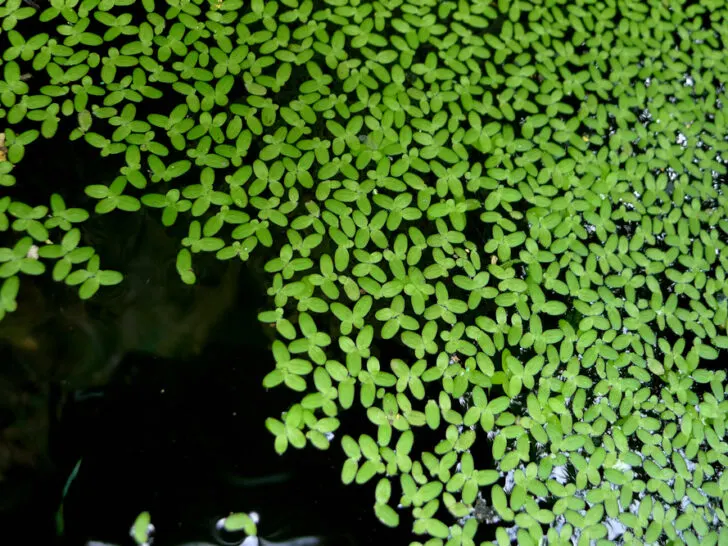
- Family: Arum or Araceae
- Tank placement: Floating
- Care level: Moderate
- Growth rate: Fast
- Water temperature: 72 to 86°F (22 – 30°C)
- Water pH: Between 6.0 – 7.5
- Water hardness: 4 – 5 dKH
- Water current: Gentle water flow
Dwarf Water Lettuce, scientifically known as Pistia stratiotes, is a fantastic floating plant option for your aquarium. Its unique feature is the pinkish-red color on the bottom of its leaves, which adds visual appeal to your tank.
This plant thrives when allowed to float freely on the surface of the water. It doesn’t require any special lighting and can grow in a variety of water conditions. Taking care of Dwarf Water Lettuce is considered moderately difficult, making it suitable for both beginner and experienced aquarium enthusiasts.
5. Hornwort ‘Ceratophyllum demersum’
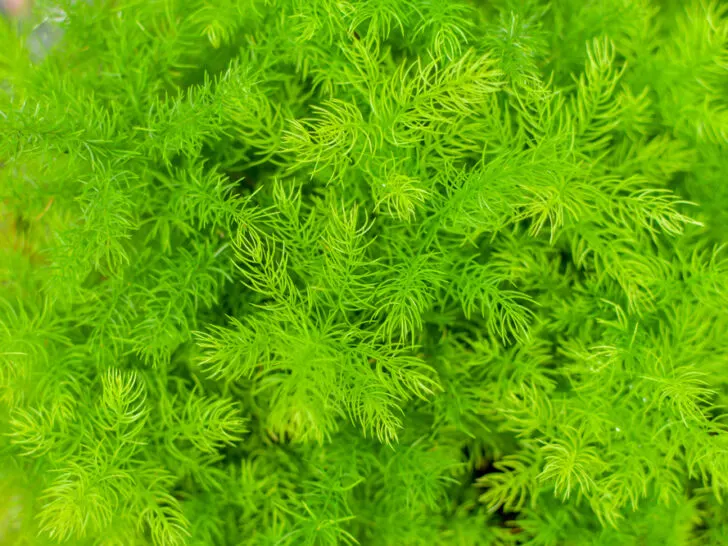
- Family: Ceratophyllaceae
- Tank placement: Floating
- Care level: Easy
- Growth rate: Fast
- Water temperature: Between 59 – 86°F (15 – 30°C)
- Water pH: Between 6.0 – 7.5
- Water hardness: 5 – 15 dGH
- Water current: Gentle water flow
Hornwort, scientifically known as Ceratophyllum demersum, adds beauty and natural elegance to any tank. It has pinkish-red leaves at the bottom that create a stunning visual effect when the water moves, resembling gentle waves in your aquarium.
Taking care of Hornwort is fairly easy to look after, making it suitable for both beginner and experienced aquarists. One important aspect of maintaining Hornwort is regular trimming to keep its shape and prevent overgrowth.
One thing to keep in mind with this plant is that it will shed its needles when there are significant shifts in water conditions or when it’s in an unfavorable environment. This can happen due to strong currents, a lack of nutrients, insufficient light, or the use of certain chemicals like liquid carbon.
6. Water Wisteria ‘Hygrophila difformis’

- Family: Acanthaceae
- Tank placement: Floating or carpet
- Care level: Easy
- Growth rate: Fast
- Water temperature: Between 70 – 82°F (21 – 27°C)
- Water pH: Between 6.5 – 7.5
- Water hardness: 2 – 8 dKH
- Water current: Gentle water flow
Water Wisteria, scientifically known as Hygrophila difformis is a beautiful floating plant with its pinkish-red leaves, creating a wave-like effect of color in the water.
Highly recommended for any tank, Water Wisteria provides great cover for fish and helps reduce their stress levels. Care should be taken when trimming this plant to protect the delicate stems.
If you are floating the Wisteria, make sure it doesn’t cover more than 50% of the water surface. Excessive coverage can block light from other plants and result in stagnant water with low oxygen levels.
7. Banana Plant ‘Nymphoides aquatica’

- Family: Musaceae
- Tank placement: Floating or planted
- Care level: Easy
- Growth rate: Moderate
- Water temperature: Between 68 – 82°F (20 – 27.8°C)
- Water pH: Between 6.0 to 7.5
- Water hardness: 5 -12 dKH
- Water current: Gentle water flow
Banana plant, scientifically known as Nymphoides aquaticais is a popular choice for aquariums due to its unusual shape.
It has thick, nutrient-storing tubers resembling a bunch of unripened bananas, with long stems that shoot up toward the surface and develop heart-shaped leaves resembling lily pads that sit on top of the water.
Caring for Banana plants is relatively straightforward. They are resilient and thrive for long durations under optimal conditions. Care requirements vary slightly depending on your tank’s needs or whether you prefer it planted or floating.
8. Crystalwort Riccia ‘Riccia fluitans’
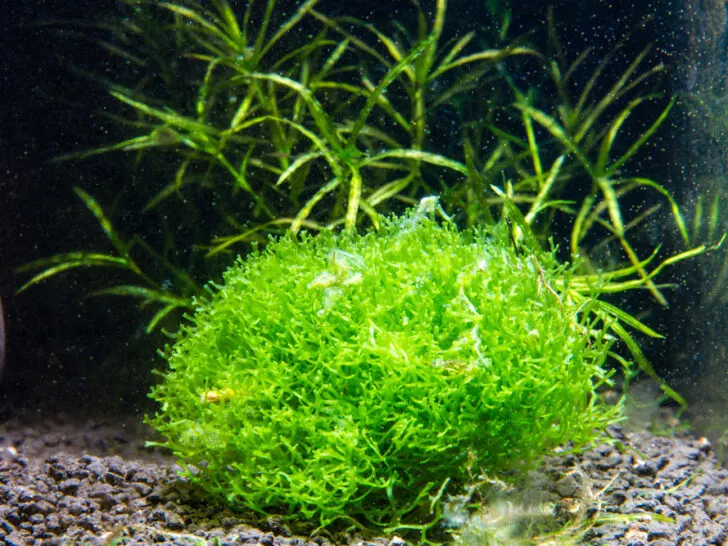
- Family: Ricciaceae
- Tank placement: Submerged Floating
- Care level: Easy
- Growth rate: Moderate
- Water temperature: Between 59 – 86°F (15 – 30°C)
- Water pH: Between 6.0 – 7.5
- Water hardness: 1 to 12 dKH
- Water current: Gentle water flow
Crystalwort, scientifically known as Riccia fluitans, is a popular choice for aquascaping due to its distinctive appearance and undemanding nature to thrive in various water conditions.
It forms bright green, flat, and often intricately branching structures that float on the water’s surface. These structures can be described as looking like small, delicate, and branching green “mats” or “carpets.” The individual branches are usually thin and thread-like, giving it a feathery appearance, and creating a lush and attractive covering on the surface of the water in aquariums or ponds.
In addition to its aesthetic appeal and adaptability, Riccia fluitans also provide valuable shelter and refuge for aquatic friends, such as fry and small fish, enhancing the ecological balance of aquariums and ponds.
9. Java Moss ‘Vesicularia dubyana’

- Family: Hypnaceae
- Tank placement: Floating or carpet
- Care level: Easy
- Growth rate: Fast
- Water temperature: Between 70 – 75°F (21 – 24°C)
- Water pH: Between 6.5 – 7.5
- Water hardness: 6–20 dGH
- Water current: Gentle water flow
Java Moss, scientifically known as Vesicularia dubyana, is a highly recommended plant for your fish tank. It showcases an intriguing wave-like effect of color, thanks to the pinkish-red undersides of its leaves.
This fast-growing aquatic plant can easily latch onto various surfaces in your aquarium, providing excellent hiding spots for your fish. Although taking care of Java Moss requires moderate effort, it’s well worth it for the lush greenery and aesthetic appeal it adds to any freshwater tank setup.
10. Water Spangles ‘Salvinia minima’
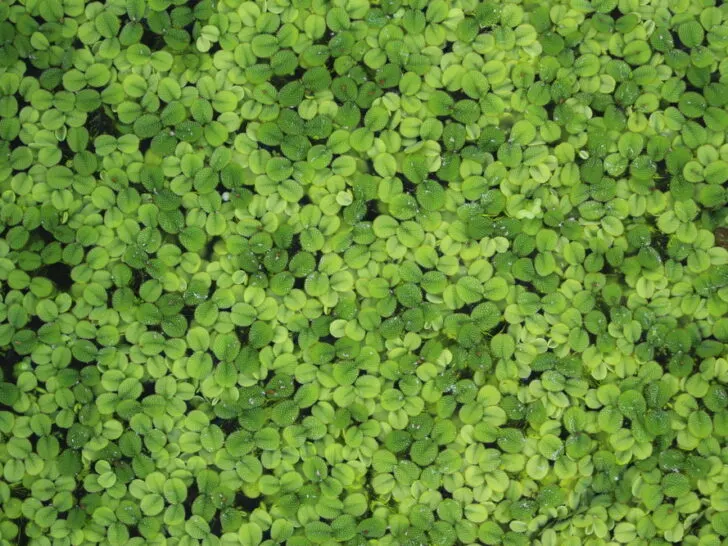
- Family: Salviniaceae
- Tank placement: Floating
- Care level: Easy
- Growth rate: Very fast
- Water temperature: Between 72 – 79°F (22 – 26°C)
- Water pH: Between 6.0 – 8.0
- Water hardness: Between 8 to 12 dGH
- Water current: Gentle water flow
Water Spangles, scientifically known as Salvinia minima, are a popular type of floating aquarium plant with long roots and small, floating leaves. These plants create a beautiful green carpet effect on the water’s surface, providing shade and cover for fish.
These plants have pinkish-red bottoms on their leaves, adding a beautiful touch of color to your aquatic setup.
Taking care of Water Spangles is considered moderate in terms of difficulty, making them suitable for both beginners and experienced hobbyists. One of the great advantages of these plants is their ability to survive in various water conditions, including low light and fluctuating temperatures.
However, it’s important to note that the long roots of Water Spangles may interfere with fish swimming. On the bright side, Water Spangles reproduce rapidly, which can be beneficial in absorbing excess nutrients and reducing algae growth in your aquarium.
11. Anacharis ‘Egeria najas’

- Family: Hydrocharitaceae
- Tank placement: Floating
- Care level: Easy
- Growth rate: Fast
- Water temperature: Between 72 – 78°F (22 – 25°C)
- Water pH: Between 6.5 – 7.5
- Water hardness: 3 – 8 dKH
- Water current: Gentle water flow
Anacharis, also known as Egeria najas (Egeria densa), is an appealing floating aquarium plant valued for its delicate yet vibrant appearance. This aquatic favorite proudly displays a riot of color with pinkish-red hues gracing the underside of its leaves, creating a captivating wave-like effect whenever it sways in the water current.
As beautiful as Anacharis is to behold though, aquarists must note that their maintenance holds moderate challenges. Regular trimming becomes an essential routine task to preserve compactness and prevent unruly growth from overtaking your aquatic space.
Despite this slight hurdle, many find Anacharis’ beauty worth every bit of effort devoted to its care!
12. Water Sprite ‘Ceratopteris thalictroides’
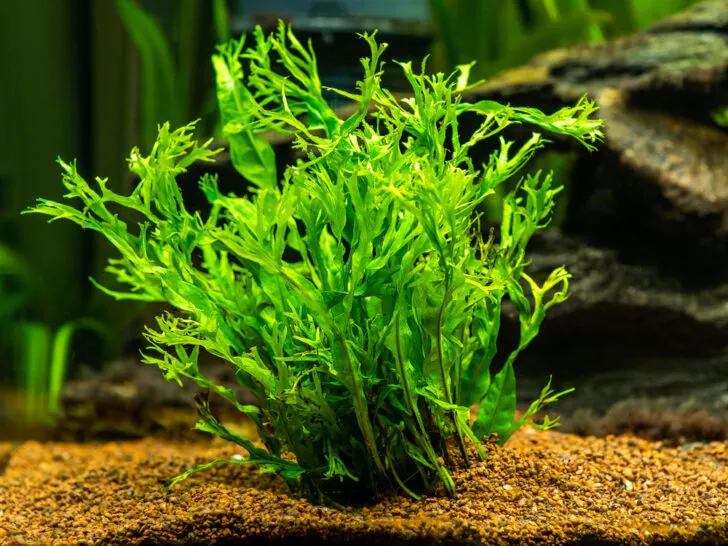
- Family: Pteridaceae
- Tank placement: Floating or planted
- Care level: Easy
- Growth rate: Low to moderate
- Water temperature: Between 68 – 82°F
- Water pH: Between 6.0-7.5
- Water hardness: 3 – 8 dKH
- Water current: Gentle to moderate water flow
Water Sprite, scientifically known as Ceratopteris thalicotoides is a popular floating aquarium plant that is highly recommended. Its pinkish-red leaves create a striking contrast in the aquarium and can enhance the visual appeal when water or swimming fish create a wave-like effect with their movement.
In addition to its aesthetic value, Water Sprite provides great cover for fish that need a place to hide, reducing stress levels in the tank. While taking care of Water Sprite can be moderately difficult, it is important to protect the stems and be cautious when trimming this plant.
13. Rotala Indica ‘Rotála indica’

- Family: Lythraceae
- Tank placement: Floating or planted
- Care level: Easy to moderate
- Growth rate: Fast
- Water temperature: Between 72°F to 82°F (22°C to 28°C)
- Water pH: Between 6.0 – 7.0
- Water hardness: 3 – 8 dKH
- Water current: Gentle water flow
Rotala Indica features slender, delicate stems with alternating, narrow, and vibrant green leaves. Its appearance is characterized by the growth of numerous fine branches and leaves that give it a bushy and feathery look. The leaves may exhibit slight reddish or pinkish hues when exposed to high light conditions, adding to its visual appeal.
This sturdy plant doesn’t need much care and can survive in harsh environments. It thrives in tanks and grows quickly, so it gives beginners an opportunity to learn how to prune tank plants.
14. Creeping primrose-willow ‘Ludwigia Repens’
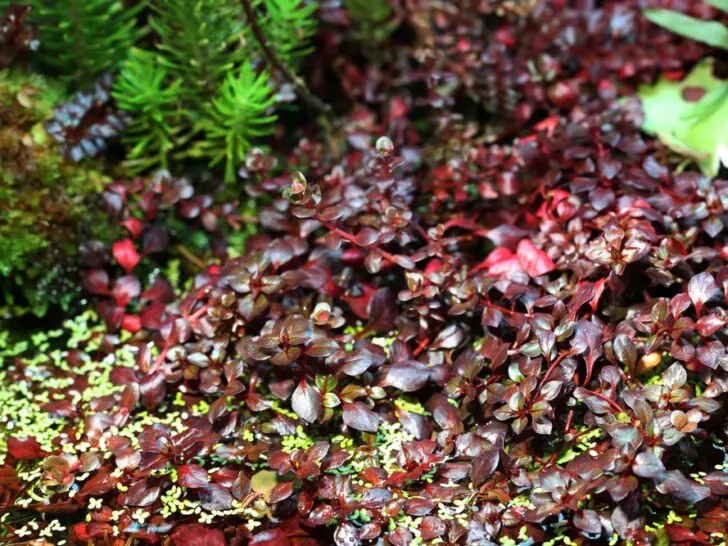
- Family: Onagraceae
- Tank placement: Floating or planted
- Care level: Easy
- Growth rate: Fast
- Water temperature: Between 68 – 82°F (20 – 28°C)
- Water pH: Between 6.0 – 8.0
- Water hardness: 3 – 8 dKH
- Water current: Gentle water flow
Ludwigia Repens is a popular floating aquarium plant that can add beauty and functionality to your fish tank. It has the ability to grow above the water surface if allowed to float freely, creating an interesting visual effect.
It has vibrant and striking red or reddish-orange stems and leaves. The leaves are typically lance-shaped and grow alternately along the stems. It can reach varying heights depending on the growing conditions, but it often forms dense clusters of red or orange foliage that create a visually captivating contrast with green aquatic plants.
This plant is known for its ability to absorb excess nutrients in the water, helping to improve water quality and prevent algae growth. In addition, It is relatively easy to care for and can tolerate a wide range of water conditions, making it suitable for beginners.
14 Floating Fern ‘Salvinia natans’
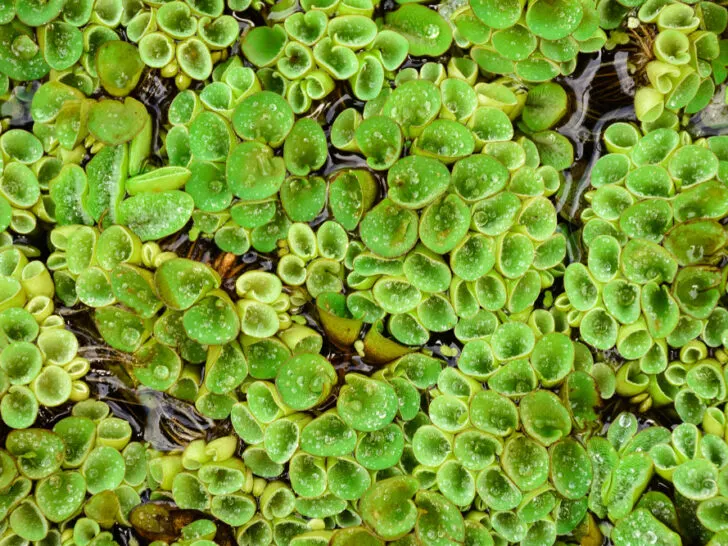
- Family: Salviniaceae
- Tank placement: Floating
- Care level: Easy
- Growth rate: Fast
- Water temperature: Between 60 – 70°F (15 – 21°C)
- Water pH: Between 6.5 – 7.5
- Water hardness: 4 – 20 dGH
- Water current: Gentle water flow
Salvinia natans is a less common type of floating aquarium plant, but it offers several benefits for your tank. Its nickel-sized leaves are filled with air pouches, which help the plant float on the water’s surface.
Salvinia is often used in aquariums to provide shade and cover for fish, creating a natural habitat and allowing them to hide if they feel stressed or threatened. Additionally, this plant can help maintain water quality by absorbing excess nutrients, reducing the risk of algae overgrowth.
Another advantage of Salvinia is that it has lower lighting requirements compared to other floating plants, making it an ideal choice for tanks with less intense light conditions.
5 Benefits of Floating Aquarium Plants
Floating aquarium plants have several benefits, including providing shade and cover for your fish, serving as a dietary supplement, aiding in aeration and oxygenation, offering natural filtration for the tank, and the ability to absorb excess nutrients to help prevent algae growth.
1. Providing Shade And Cover
This can be an effective stress reliever, especially for shy or territorial species that prefer solitude and protection from bright lighting. You’ll also find certain types of fish love this plant-made haven as an ideal spot to lay their eggs – an essential aspect when breeding within the tank environment.
Floating plants serve a significant role in providing shade and cover for your fish. The shelter cast by the leaves of these plants creates a natural, comfortable hideaway for your aquatic friends and tank mates.
Floating plants not only emulate the conditions of wild habitats but also enhance the wellbeing of your underwater friends by offering ample hiding places and dimmed light spaces.
2. Dietary Supplement For Fish
Floating aquarium plants play a crucial role in boosting the nutritional intake of fish. Many species munch on these green delicacies, gaining essential vitamins and minerals from their diet that commercial feed might not fully provide.
Aquarium plants like Water Sprite, Hornwort, and Java Moss are well-known for their nutritious benefits.
Furthermore, floating aquarium plants are an excellent source of fiber which aids in your fish’s digestion. They also act as a natural laxative preventing constipation problems among fish.
So it’s not just about aesthetics or creating hideouts – these aquatic heroes contribute significantly to overall fish health too.
3. Aeration & Oxygenation
Floating plants play a pivotal role in promoting aeration and oxygenation in the aquatic environment. They achieve this through photosynthesis, a process that yields oxygen as its byproduct.
As these plants respire throughout daylight hours, they continually saturate the water with much-needed oxygen. This constant supply of oxygen is crucial for fish and other underwater creatures who rely on it for survival.
It’s important to note that not only do their actions contribute to elevated oxygen levels but also aid in reducing carbon dioxide concentrations within the ecosystem. By fostering enhanced gas exchange, floating aquarium plants ensure your tank remains a healthy and balanced habitat for your beloved tank mates.
4. Natural Tank Filtration
Floating plants play a pivotal role in maintaining the water quality of your fish tank. They are Mother Nature’s own filtration system, readily absorbing excess nutrients such as nitrates and phosphates from the water.
This not only keeps the water healthy for your aquatic friends but also helps curb unwanted growths like algae.
Excess nutrients can easily cause an imbalance in your aquarium’s ecosystem. Floating plants consume these nutrients directly from the water, effectively reducing their levels without any additional work needed on your part.
Let these natural purifiers do their job while you simply appreciate the beauty they lend to your aquarium setup.
5. Absorb Excess Nutrients & Prevent Algae Growth
Floating aquarium plants play an important role in maintaining the health and balance of your tank. One of their key benefits is their ability to absorb excess nutrients in the water, which helps prevent algae growth.
For example, the Anacharis plant is highly recommended for its excellent nutrient absorption capabilities. Another popular floating plant, Water Sprite, also contributes to this process by absorbing excess nutrients and preventing excessive algae growth.
By incorporating these plants into your aquarium, you can create a healthier environment for your fish while minimizing the presence of unsightly algae.
Choosing Floating Aquarium Plants
When selecting floating plants for your aquarium, it’s important to take into account various factors, including lighting, water current, pH, water hardness, temperature, CO2 levels, nutrient availability, and whether you intend to use a cover on your aquarium.
Water Filter
To ensure the health and cleanliness of your aquarium, it’s crucial to choose the right filter. A good filter will help remove excess waste and harmful substances from the water, keeping it clean and safe for your fish.
Consider factors such as the size of your tank, filtration capacity, and ease of maintenance when selecting a filter. Regularly cleaning and changing the filter media is also important to maintain optimal filtration efficiency.
By choosing the right filter for your aquarium, you can create a clean and balanced environment that promotes the well-being of your aquatic pets.
Lighting
Proper lighting is an important consideration when setting up a tank for floating plants. The right amount of light can enhance the visual appeal of your aquarium, especially with plants that have vibrant and colorful leaves.
Different floating plants may have different lighting requirements, so it’s crucial to choose plants that are compatible with the lighting in your tank. By providing adequate light, you can ensure the healthy growth of your floating plants and prevent them from becoming overgrown if they’re not properly maintained.
Water Current
Water current plays a crucial role when it comes to selecting floating aquarium plants. Not all plants can tolerate strong currents, so it’s important to keep them away from powerful filtration units.
Understanding the water current preferences of floating plants is essential for ensuring compatibility with fish and other plants in the tank. By considering water currents, you can create an environment that allows these plants to thrive.
Water pH & Hardness
Different floating aquarium plants have varying preferences when it comes to pH and hardness levels. It is important to consider these factors when choosing which plants to add to your tank.
Testing the water chemistry levels regularly can ensure that the pH and hardness are within the suitable range for the plants’ survival.
Water Temperature
It’s important to consider the temperature of your tank when choosing and caring for these plants. Some floating plants prefer warmer temperatures, while others prefer cooler temperatures.
It’s crucial to ensure that the temperature is suitable for both your fish and the floating plants. Temperature fluctuations can have an impact on the growth and overall health of the plants, so maintaining a stable temperature is essential for their well-being.
CO2 & Nutrients
Floating plants play an important role in maintaining water quality by absorbing excess nutrients, including CO2. These plants help to keep the water clean and balanced, creating a healthier environment for your fish.
By removing CO2 and other pollutants from the water, floating plants like Hornwort and Java moss act as natural filters, contributing to improved water quality.
Lidless/Hoodless
For those considering floating plants in their aquarium, going lidless/hoodless is an important aspect to consider. This means removing the cover or hood from your tank to allow the floating plants to thrive.
By doing so, you create an open environment where the plants can have direct access to light and air circulation. This setup allows for optimal growth and ensures that the floating plants receive all the nutrients they need.
So, if you’re looking to add a touch of beauty and natural filtration to your aquarium, going lidless/hoodless is definitely worth considering.
Caring For Floating Plants
Quarantine, feeding, CO2 injection, propagation techniques, and tank maintenance are important aspects to consider for the care and propagation of floating plants in your aquarium. Learn how to keep your floating plants healthy and thriving by reading more.
Quarantine
Quarantining aquarium plants is crucial because it helps prevent the introduction of diseases, pests, and unwanted organisms into your main tank. When new plants are added to an aquarium, they can carry harmful pathogens or pests, which may go unnoticed.
Quarantining allows you to observe and treat any potential issues in isolation, protecting your established tank and its inhabitants from potential harm. This practice helps maintain the health and balance of your aquatic ecosystem while reducing the need for chemical treatments in the main tank.
Feeding
Floating aquarium plants do not require any specific feeding. These plants obtain nutrients from the water and photosynthesis, so there is no need to supplement their diet with additional food.
They can absorb excess nutrients in the water, which helps prevent algae growth and maintain a healthy ecosystem in your tank. However, it’s important to regularly test your water parameters to ensure that the nutrient levels are balanced for both the floating plants and other inhabitants of your aquarium.
CO2 Injection
Adding CO2 to your aquarium can greatly benefit the growth and health of floating plants. Carbon dioxide (CO2) is essential for photosynthesis, the process by which plants convert light into energy.
By injecting CO2 into your tank, you can provide floating plants with an abundant supply of carbon, allowing them to grow and thrive. This can result in faster growth rates, lusher foliage, and more vibrant colors for your floating plants.
Additionally, CO2 injection can help balance pH levels and promote a healthy ecosystem in your aquarium.
Other Plants And Tankmates
When adding floating plants to your aquarium, it’s important to consider the other plants and tankmates you have. Some floating plants can grow rapidly and cover the surface of the water, blocking light from reaching other plants below.
It’s best to choose floating plants that won’t overshadow or crowd out your other aquatic vegetation. Additionally, some fish may see the long roots of certain floating plants as a place to hide or lay their eggs.
Keep this in mind when selecting tankmates for your floating plant-filled aquarium. By considering the compatibility of your chosen floating plants with other flora and fauna, you’ll create a balanced and harmonious underwater ecosystem.
How To Keep Them In Check
To keep floating plants in check in your aquarium, it’s important to regularly monitor their growth. Some floating plants have a tendency to multiply rapidly and can quickly cover the surface of the water if left unchecked.
One way to control their growth is by manually removing excess plants on a regular basis. This will prevent them from overtaking your tank and crowding out other aquatic life. Additionally, you can trim or prune the floating plants as needed to maintain their size and shape.
By keeping an eye on their growth and implementing these measures, you can ensure that your floating plants stay manageable and contribute positively to your aquarium ecosystem.
Floating Plant FAQs
What are the best floating aquarium plants for beginners?
The best floating aquarium plants for beginners include Water lettuce, Duckweed, and Java moss due to their easy care requirements.
Why should I add floating plants to my fish tank?
Adding floating plants to your fish tank can help balance excess nutrients, provide shelter for fish, enhance aquatic habitats, and oxygenate the water conditions in your aquarium.
How do I choose the right type of floater for my planted tank?
Choosing the right floater depends on several factors, including the plant’s light requirements, preferred water temperatures, and whether they thrive best when left to float freely or attached within your freshwater tank.
Can all types of fish co-exist with floating aquarium plants?
Yes! Most species like betta fish love having aquatic plants in their environments but it’s also important to consider each species’ specific needs before adding any new plant into their habitat.
What’s unique about Brazilian pennywort as a type of floating plant?
Brazilian Pennywort is versatile among other popular choices; it can be rooted in substrate or allowed to float where it will develop short roots while providing great cover at surface level benefiting both beginner and advanced aquarists alike!
Wrapping Up
Floating aquarium plants offer numerous benefits for fish keepers. They provide shade and cover, serving as hiding spots for fish and creating a natural habitat. Additionally, these plants act as a dietary supplement for fish by providing additional nutrition.
They also play a crucial role in maintaining water quality by absorbing excess nutrients and filtering the tank naturally. With their ability to increase oxygen levels through photosynthesis, floating plants contribute to better water conditions for your fish.
When choosing floating aquarium plants, it is essential to consider factors such as lighting requirements and water current preferences. Different species have varying needs when it comes to these aspects.
If you select the right plants that fit your tank’s specific conditions, you can ensure optimal growth and health.

